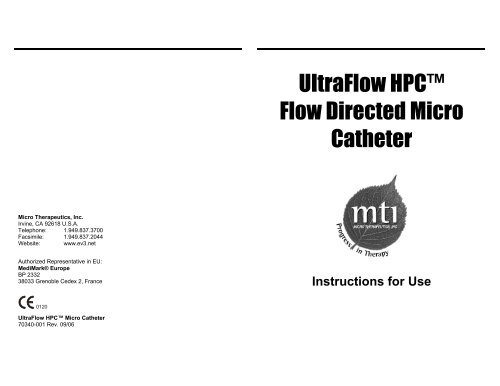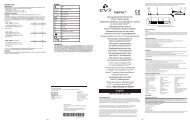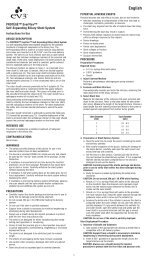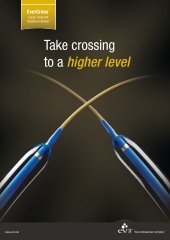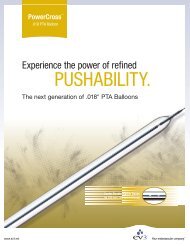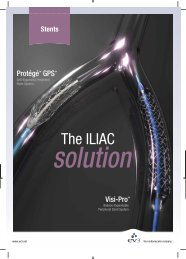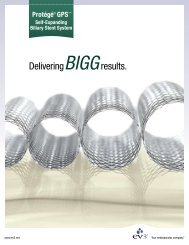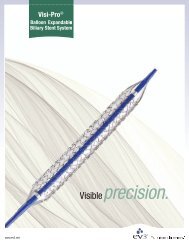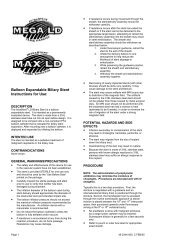UltraFlow HPC⢠Flow Directed Micro Catheter - eV3
UltraFlow HPC⢠Flow Directed Micro Catheter - eV3
UltraFlow HPC⢠Flow Directed Micro Catheter - eV3
Create successful ePaper yourself
Turn your PDF publications into a flip-book with our unique Google optimized e-Paper software.
<strong>Micro</strong> Therapeutics, Inc.<br />
Irvine, CA 92618 U.S.A.<br />
Telephone: 1.949.837.3700<br />
Facsimile: 1.949.837.2044<br />
Website: www.ev3.net<br />
Authorized Representative in EU:<br />
MediMark® Europe<br />
BP 2332<br />
38033 Grenoble Cedex 2, France<br />
0120<br />
<strong>Ultra<strong>Flow</strong></strong> HPC <strong>Micro</strong> <strong>Catheter</strong><br />
70340-001 Rev. 09/06<br />
<strong>Ultra<strong>Flow</strong></strong> HPC<br />
<strong>Flow</strong> <strong>Directed</strong> <strong>Micro</strong><br />
<strong>Catheter</strong><br />
Instructions for Use
International Symbols Glossary Glosario de símbolos internacionales<br />
LOT<br />
REF<br />
Attention, See instructions for<br />
use<br />
Use by<br />
Lot Number LOT<br />
Do Not Reuse<br />
Catalogue Number REF<br />
Atención. Ver las<br />
intrucciones de uso<br />
Fecha de caduciadad<br />
Número de lote<br />
No volver a utilizar<br />
Número de catálogo<br />
STERILE EO Sterile (Ethylene Oxide) STERILE EO Estéril (óxido de etileno)<br />
0120<br />
Date of Manufacture<br />
The product is placed on the<br />
market in conformity with<br />
Directive 93/42/EEC relating to<br />
medical devices<br />
0120<br />
Fecha de fabricación<br />
Este producto se comercializa<br />
en conformidad con la<br />
normative 93/42/EEC sobre<br />
dispositivos medicos<br />
Contents Contents of Package Contents Contenidos del paquete<br />
Glossario de simboli internazionali Symboles internationaux<br />
LOT<br />
REF<br />
Attenzione: leggere le<br />
istruzioni per l’uso.<br />
Data di scadenza<br />
Numero di lotto LOT<br />
Non riutilizzare.<br />
Numero di catalogo REF<br />
Attention. Consulter le mode<br />
d’emploi<br />
Utiliser avant<br />
N° du lot<br />
Ne pas réutiliser<br />
Numéro de catalogue<br />
STERILE EO Sterile (ossido di etilene) STERILE EO Stérile (oxyde d’éthylène)<br />
0120<br />
Data di fabbricazione<br />
Questo prodotto è<br />
commercializzato in conformità<br />
alla direttiva 93/42/CEE relativa<br />
ai dispositivi medici.<br />
0120<br />
Date de fabrication<br />
Ce produit est commercialisé<br />
conformément aux dispositions<br />
de la directive 93/42/CEE<br />
relative aux dispositifs et<br />
appareils médicaux<br />
Contents Contenuto della confezione Contents Contenu de l’emballage
Portuguese (Pg. 4 of 4)<br />
PRECAUÇÃO:<br />
Dificuldade em retirar o cateter ou cateter preso pode acontecer por um dos seguintes motivos:<br />
• Angio-arquitectura: Malformações arterio-venosas muito distais alimentadas por pedículos<br />
aferentes, alongados e tortuosos.<br />
• Vasoespasmo<br />
• Refluxo<br />
• Longa permanência do cateter no interior<br />
• Propriedades adesivas de alguns materiais embólicos<br />
Se existir suspeita da imobilização do cateter (por qualquer agente embólico) a remoção do cateter utilizando<br />
uma técnica de puxar mais de 20 cm pode causar a separação do eixo do cateter e danos potenciais à<br />
vasculatura.<br />
1. Remova devagar qualquer ‘folga’ no eixo proximal do cateter.<br />
2. Aplique de 3-5 cm de tracção ao cateter, devagar e com cuidado, para iniciar a recuperação do cateter.<br />
3. Se a remoção do cateter se tornar difícil, o procedimento seguinte fornecerá assistência na recuperação<br />
do cateter. Avalie os parâmetros seguintes observando o eixo proximal do cateter:<br />
♦ Vaso a estreitar-se<br />
♦ Tracção no cilindro embólico<br />
♦ Ponta do cateter a soltar-se do cilindro embólico<br />
4. Se necessário, pode ser aplicada mais tracção (de 3-5 cm) para transferir força para o eixo proximal do<br />
cateter.<br />
♦ Conservar esta tracção por alguns segundos e depois soltar<br />
♦ Avaliar tracção da vasculatura para minimizar o risco de hemorragia<br />
5. Este processo pode ser repetido intermitentemente até o cateter ter sido recuperado.<br />
NOTA: Não aplicar mais de 20 cm de tracção ao cateter a fim de minimizar o risco de separação do<br />
cateter.<br />
6. Em situações clínicas difíceis, pode ser mais seguro deixar um cateter orientado por fluxo sanguíneo no<br />
sistema de vasculatura, em vez de arriscar a ruptura da malformação e, consequentemente uma<br />
hemorragia, devido a se aplicar demasiada tracção num cateter preso.<br />
Isto é conseguido esticando o cateter e cortando o eixo perto do ponto de entrada do acesso vascular<br />
permitindo que o cateter permaneça na artéria.<br />
Se durante a remoção o cateter se partir, poderá ocorrer migração proximal ou encaracolamento do<br />
cateter. Deve ser considerada resecção cirúrgica, executada no mesmo dia para minimizar o risco de<br />
trombose.<br />
CAUTION<br />
English (Pg. 1 of 4)<br />
<strong>Ultra<strong>Flow</strong></strong> HPC <strong>Micro</strong> <strong>Catheter</strong><br />
INSTRUCTIONS FOR USE<br />
• Federal (USA) law restricts this device to sale, distribution, and use by or on the order of a physician.<br />
• This device should be used only by physicians with a thorough understanding of angiography and<br />
percutaneous neurointerventional procedures.<br />
STERILE EO<br />
It is important to read the instructions for use with careful attention to cautions, notes and<br />
warnings prior to using this product.<br />
STERILE: This device is sterile and non-pyrogenic. Sterilized using ethylene oxide gas.<br />
Do not use if pouch is open or damaged.<br />
This device is intended for SINGLE USE ONLY. DO NOT RESTERILIZE AND/OR<br />
REUSE.<br />
CONTENTS: One <strong>Ultra<strong>Flow</strong></strong> HPC <strong>Flow</strong> <strong>Directed</strong> <strong>Micro</strong> <strong>Catheter</strong> with stylet and shaping mandrel.<br />
DESCRIPTION<br />
The <strong>Ultra<strong>Flow</strong></strong> HPC <strong>Flow</strong> <strong>Directed</strong> <strong>Micro</strong> <strong>Catheter</strong> is a single-lumen, endhole catheter designed for the<br />
subselective infusion of physician-specified therapeutic agents such as embolization materials and diagnostic<br />
materials susch as contrast media in tortuous, distal vessels. The catheter has a semi-rigid proximal shaft and a<br />
highly flexible distal shaft to facilitate the advancement of the catheter in the anatomy. The proximal end of the<br />
catheter incorporates a standard luer adapter to facilitate the attachment of accessories. The catheter has a<br />
radiopaque marker at the distal end to facilitate fluoroscopic visualization. The outer surfaces of the catheter<br />
are coated to increase lubricity. The stylet accompanying the catheter is used to increase the rigidity of the<br />
distal section during introduction into the guiding catheter.<br />
INDICATIONS FOR USE<br />
The <strong>Ultra<strong>Flow</strong></strong> HPC <strong>Flow</strong> <strong>Directed</strong> <strong>Micro</strong> <strong>Catheter</strong> is intended to access peripheral and neuro vasculature for<br />
the controlled selective infusion of physician-specified therapeutic agents such as embolization materials and of<br />
diagnostic materials such as contrast media. Not intended for use in the coronary vasculature.<br />
CONTRAINDICATIONS<br />
The <strong>Ultra<strong>Flow</strong></strong> HPC <strong>Flow</strong> <strong>Directed</strong> <strong>Micro</strong> <strong>Catheter</strong> is contraindicated when, in the medical judgment of the<br />
physician, use of such product may compromise the patient's condition.<br />
The <strong>Ultra<strong>Flow</strong></strong> HPC <strong>Flow</strong> <strong>Directed</strong> <strong>Micro</strong> <strong>Catheter</strong> is contraindicated for neonatal and pediatric use.<br />
POTENTIAL COMPLICATIONS<br />
Potential complications include, but are not limited to:<br />
• Puncture site hematoma • Pain and tenderness<br />
• Vessel perforation • Thrombolytic episodes<br />
• Vessel spasm • Neurological deficits including stroke and death<br />
• Hemorrhage • Vascular thrombosis
English (Pg. 2 of 4)<br />
WARNINGS<br />
Infusion pressure with this device should not exceed 690 kPa/100 psi. Pressure in excess of 690 kPa/100 psi<br />
may result in catheter rupture, possibly resulting in patient injury.<br />
If flow through the catheter becomes restricted, do not attempt to clear the device by high pressure infusion.<br />
Either remove the catheter to determine the cause of the obstruction or replace it with a new catheter. Excessive<br />
pressure may cause catheter rupture, possibly resulting in patient injury.<br />
The stylet is not to be used as a guidewire. The stylet should never be manipulated within the catheter. Do not<br />
advance the stylet beyond the tip of the catheter. Use of the stylet as a guidewire could cause damage to the<br />
catheter and/or injure the patient.<br />
Never advance or withdraw an intraluminal device against resistance until the cause of the resistance is<br />
determined by fluoroscopy. Excessive force against resistance may result in damage to the device or vessel<br />
perforation.<br />
When injecting contrast for angiography, ensure that the catheter is not kinked, prolapsed or occluded.<br />
Verify catheter integrity prior to re-inserting guidewire or injecting embolic material to prevent vascular damage<br />
or unintended embolization. <strong>Catheter</strong> integrity is verified by angiographically confirming that contrast agent is<br />
exiting only from the catheter tip.<br />
PRECAUTIONS<br />
Prior to use, carefully examine the <strong>Ultra<strong>Flow</strong></strong> HPC and its packaging to verify that they have not been<br />
damaged during shipment.<br />
Prior to use, all accessory devices and agents should be fully prepared according to the manufacturer's<br />
instructions.<br />
Physicians should verify compatibility of therapeutic agent and/or material before use with catheter.<br />
Always monitor infusion rates when using this catheter.<br />
The <strong>Ultra<strong>Flow</strong></strong> HPC has a hydrophilic coating on the outside of the catheter which must be kept hydrated.<br />
This catheter is not intended for use with chemotherapy agents, embolization particles or coils.<br />
When the infusion catheter is in the body, it should be manipulated only under fluoroscopy. Do not attempt to<br />
move the catheter without observing the resultant tip response.<br />
Because the <strong>Ultra<strong>Flow</strong></strong> HPC may be easily advanced into narrow, selective vasculature, repeatedly verify that<br />
the <strong>Ultra<strong>Flow</strong></strong> HPC has not been advanced so far as to interfere with its removal by slightly withdrawing the<br />
catheter before each infusion. Refer to directions for use.<br />
STORAGE<br />
The <strong>Ultra<strong>Flow</strong></strong> HPC <strong>Flow</strong> <strong>Directed</strong> <strong>Micro</strong> <strong>Catheter</strong> should be stored in a dry place at between 50°F (10°C) and<br />
90°F (32°C)<br />
DIRECTIONS FOR USE<br />
<strong>Ultra<strong>Flow</strong></strong> HPC <strong>Flow</strong> <strong>Directed</strong> <strong>Micro</strong> <strong>Catheter</strong><br />
PROCEDURE<br />
1. Place the appropriate guiding catheter following recommended procedures. Connect a one-way stop-cock<br />
to the guiding catheter to prevent backflow of blood during insertion of catheter. Connect a hemostatic<br />
side arm adapter one way stop-cock to allow for insertion of catheter and to continuously flush the guiding<br />
catheter with saline.<br />
NOTE: The Ultraflow HPC micro catheter is compatible with hydrophilic guidewires with a maximum outer<br />
diameter of 0.010” (0.254mm). It is recommended that a guiding catheter with a minimum internal<br />
diameter of 0.053” (1.35 mm) be used with the <strong>Ultra<strong>Flow</strong></strong> HPC <strong>Flow</strong> <strong>Directed</strong> <strong>Micro</strong> <strong>Catheter</strong>.<br />
Portuguese (Pg. 3 of 4)<br />
2. Retirar da caixa, com cuidado, o tubo em espiral em que veio embalado o <strong>Micro</strong>cateter Orientado por<br />
Fluxo Sanguíneo <strong>Ultra<strong>Flow</strong></strong> HPC.<br />
3. Lavar o tubo em espiral com solução salina, através do adaptador Luer fêmea anexado ao tubo em<br />
espiral.<br />
4. Retirar o cateter removendo o eixo giratório da pinça e puxando delicadamente o eixo giratório.<br />
5. Inspeccionar o cateter antes de o utilizar, para verificar se existe alguma danificação. Conservar a<br />
embalagem do tubo em espiral para guardar o cateter quando quando este não estiver a ser utilizado,<br />
durante o procedimento.<br />
6. Retirar o fio-estilete da respectiva embalagem de tubo em espiral.<br />
7. Irrigar o interior do cateter com solução salina.<br />
8. Enfiar o fio-estilete no eixo giratório do microcateter. Não fazer avançar o estilete além da ponta do<br />
cateter.<br />
9. Fazer avançar o fio-estilete através do cateter, mantendo o corpo do cateter recto.<br />
10. Fechar a torneira de uma via.<br />
11. Soltar a válvula hemostática.<br />
12. Introduzir o cateter através do adaptador hemostático.<br />
13. Apertar a válvula em torno do cateter para evitar um refluxo, mas deixando alguma folga para que o<br />
cateter se possa mivimentar através da válvula.<br />
14. Abrir a torneira de uma via.<br />
15. Fazer avançar o cateter de maneira a que o estilete se mantenha no cateter-guia. Não fazer avançar o<br />
estilete além da ponta do cateter-guia.<br />
16. Uma vez que o cateter tenha sido avançado para a extremidade do cateter-guia, retirar o estilete do<br />
cateter.<br />
17. Depois do estilete ser retirado, o cateter pode ser avançado através da vasculatura empurrando<br />
delicadamente o eixo proximal.<br />
PRECAUÇÕES: Verificar a integridade do cateter, antes de introduzir o fio-guia ou de injectar o material<br />
embólico, para evitar danos vasculares ou uma embolização não pretendida. A integridade do cateter é<br />
verificada pela confirmação angiográfica de que o agente de contraste sai apenas através da ponta do<br />
cateter.<br />
18. Para injectar o líquido de infusão, colocar a seringa com o líquido no adaptador Luer do cateter, e injectar<br />
o volume necessário.<br />
Comprimento<br />
útil<br />
Espaço Morto<br />
Mínimo<br />
Características funcionais<br />
Taxa de infusão aproximada a 100 psi (690 kPa)<br />
Água<br />
Contraste (Renografina a 76%)<br />
165 cm 0,26 ml 14 ml/min 2 ml/min<br />
MANDRIL DE MODELAR A VAPOR<br />
Case se deseje, a ponta do cateter pode ser modelada a vapor com o mandril de modelar a vapor fornecido.<br />
1. Introduzir o mandril no lúmen distal do microcateter.<br />
2. Dobrar cuidadosamente a ponta do cateter e o mandril de modelar para obter a form pretendida para a<br />
ponta.<br />
3. Moldar o cateter mantendo uma secção do mesmo posicionada aproximadamente a 1 polegada (2,5 cm)<br />
de uma fonte de vapor (DURANTE NÃO MAIS QUE 30 SEGUNDOS).<br />
4. Arrefecer a ponta ao ar ou dentro de solução salina.<br />
5. Retirar o mandril.
Portuguese (Pg. 2 of 4)<br />
AVISOS<br />
A pressão com este dispositivo não deve exceder 690 kPa/100 psi. Uma pressão superior a 690 kPa/100 psi<br />
pode resultar na ruptura do cateter e causar lesões no doente.<br />
Se o fluxo através do cateter for restringido, não tentar desobstruir o dispositivo através de infusão a alta<br />
pressão. Retirar o cateter para determinar a causa da obstrução ou substituí-lo por um novo cateter. Uma<br />
pressão excessiva pode provocar a ruptura do cateter e causar lesões no doente.<br />
O estilete não deve ser utilizado como fio-guia. O estilete deve ser sempre manipulado dentro do cateter. Não<br />
fazer avançar o estilete além da ponta do cateter. Se o estilete for usado como fio-guia poderão resultar<br />
danos para o cateter e /ou lesões para o doente.<br />
Nunca fazer avançar nem retirar um dispositivo intraluminal contra uma resistência até que a causa da<br />
resistência tenha sido determinada por fluoroscopia. Uma força excessiva contra a resistência pode resultar em<br />
danos para um dispositivo ou na perfuração de um vaso.<br />
Ao injectar solução de contraste para angiografia, verificar se a superfície do cateter não apresenta dobras nem<br />
oclusões.<br />
Verificar a integridade do cateter, antes de introduzir o fio-guia ou de injectar o material embólico, para evitar<br />
danos vasculares ou uma embolização não pretendida. A integridade do cateter é verificada pela confirmação<br />
angiográfica de que o agente de contraste sai apenas através da ponta do cateter.<br />
PRECAUÇÕES<br />
Antes de utilizar, examinar cuidadosamente o <strong>Ultra<strong>Flow</strong></strong> HPC e a respectiva embalagem para verificar se os<br />
mesmos sofreram algum dano no processo de expedição.<br />
Todos os acesórios e agentes devem estar completamente preparados de acordo com as instruções do<br />
fabricante, antes de serem utilizados.<br />
Os médicos devem verificar a compatibilidade dos agentes terapêuticos e/ou materiais antes da sua utilização<br />
com o cateter.<br />
Seguir as taxas de infusão ao utilizar este cateter.<br />
A superfície externa do cateter <strong>Ultra<strong>Flow</strong></strong> HPC é revestida de uma matéria hidrófíla, que se deve manter<br />
permanentemente hidratada.<br />
Este cateter não se destina a ser usado com agentes de quimoterapia, partículas de embolização ou tubo em<br />
espiral.<br />
Quando o cateter de infusão se encontrar no corpo do doente, só deverá ser manipulado sob fluoroscopia. Não<br />
tentar deslocar o cateter sem antes observar a resultante reacção da ponta.<br />
Como o <strong>Ultra<strong>Flow</strong></strong> HPC pode, facilmente, ser avançado para uma vasculatura selectiva estreita, verificar<br />
várias vezes se o mesmo não foi avançado de tal modo que dificultará a sua própria remoção, fazendo-o<br />
retroceder ligeiramente antes de cada infusão. Consulte as instruções de utilização.<br />
ARMAZENAMENTO<br />
O <strong>Micro</strong>cateter Orientado por Fluxo Sanguíneo <strong>Ultra<strong>Flow</strong></strong> HPC deve ser guardado num local seco com<br />
temperaturas entre os 10° C (50° F) e os 32° C (90° F).<br />
INSTRUÇÕES DE UTILIZAÇÃO<br />
<strong>Ultra<strong>Flow</strong></strong> HPC, <strong>Micro</strong>cateter Orientado por Fluxo Sanguíneo<br />
PROCEDIMENTO<br />
1. Colocar o cateter-guia apropriado seguindo os procedures recomendados. Colocar uma torneira de uma<br />
vias no cateter-guia, a fim de evitar que ocorra um refluxo de sangue durante a inserção do cateter.<br />
Colocar um adaptador hemostático de braço lateral na torneira de uma via para permitir que o que o<br />
cateter seja inserido e seja continuamente irrigado com solução salina.<br />
OBSERVAÇÃO: O microcateter <strong>Ultra<strong>Flow</strong></strong> HPC é compatível com fios-guia hidrofílicos com um<br />
diâmetro externo máximo de 0.254 mm (0.010”). Recomenda-se que seja utilizado um cateter-guia com<br />
um diâmetro interno mínimo de 0,053 (1.35 mm) polegadas com o <strong>Micro</strong>cateter Orientado por Fluxo<br />
Sanguíneo <strong>Ultra<strong>Flow</strong></strong> HPC.<br />
English (Pg. 3 of 4)<br />
2. Gently remove the packaging coil for the <strong>Ultra<strong>Flow</strong></strong> HPC <strong>Flow</strong> <strong>Directed</strong> <strong>Micro</strong> <strong>Catheter</strong> from the box.<br />
3. Flush the coil with saline through the female luer attached to the coil.<br />
4. Remove the catheter by removing the hub from the clip and gently pulling on the hub.<br />
5. Inspect the catheter prior to use to verify that it is undamaged. Retain the packaging coil for storage of the<br />
catheter when it is not in use during the procedure.<br />
6. Remove the stylet wire from its packaging coil.<br />
7. Flush the ID of the catheter with saline.<br />
8. Insert the stylet wire through the hub of the <strong>Micro</strong> <strong>Catheter</strong>. Do not advance the stylet past the tip of the<br />
catheter.<br />
9. Advance the stylet wire through the catheter, keeping the catheter body straight.<br />
10. Close the one-way stop-cock.<br />
11. Loosen the hemostatic valve.<br />
12. Introduce the catheter through the hemostatic adapter.<br />
13. Tighten the valve around the catheter to prevent backflow, but allowing some movement through the valve<br />
by the catheter.<br />
14. Open the one-way stop-cock.<br />
15. Advance the catheter such that the stylet remains in the guiding catheter. Do not advance the stylet<br />
past the tip of the guiding catheter.<br />
16. Once the catheter has been advanced into the end of the guiding catheter, withdraw the stylet from the<br />
catheter.<br />
17. Once the stylet is removed, the catheter may be advanced through the vasculature by gently pushing the<br />
proximal shaft.<br />
WARNING: Verify catheter integrity prior to re-inserting guidewire or injecting embolic material to prevent<br />
vascular damage or unintended embolization. <strong>Catheter</strong> integrity is verified by angiographically confirming<br />
that contrast agent is exiting only from the catheter tip.<br />
18. To infuse, connect a syringe with infusate to the catheter luer, and infuse as required.<br />
Functional Characteristics<br />
Usable Length<br />
Minimum Dead<br />
Space<br />
Approximate Infusion Rate at 100 psi (690 kPa)<br />
Water Contrast (76% Renografin)<br />
165 cm 0.26 ml 14 ml/min 2 ml/min<br />
STEAM SHAPING MANDREL<br />
If desired, the tip of the catheter may be steam shaped using the steam shaping mandrel provided.<br />
1. Insert the mandrel into the <strong>Micro</strong> <strong>Catheter</strong>’s distal lumen.<br />
2. Carefully bend catheter tip and shaping mandrel to the desired tip shape.<br />
3. Shape the catheter by holding the shaped portion approximately 1 inch (2.5 cm) from the steam source<br />
(DO NOT EXCEED 30 SECONDS).<br />
4. Cool tip in air or saline.<br />
5. Remove mandrel.
English (Pg. 4 of 4)<br />
PRECAUTION:<br />
Difficult catheter removal or catheter entrapment may be caused by any of the following:<br />
• Angioarchitecture: very distal AVM fed by afferent, lengthened and tortuous pedicles<br />
• Vasospasm<br />
• Reflux<br />
• Long catheter dwell time<br />
• Adhesive properties of some embolic materials<br />
If catheter entrapment is suspected (with any embolic agent) catheter retrieval of using more than a 20cm pull<br />
technique may result in catheter shaft separation and potential vascular damage.<br />
1. Slowly remove any ‘slack’ in the distal catheter shaft.<br />
2. Gently and slowly apply 3-5 cm traction to the catheter to begin catheter retrieval.<br />
3. Should catheter removal become difficult, the following will assist in catheter retrieval. Assess the<br />
following parameters by observing the distal shaft of the catheter:<br />
♦ Vessel straightening<br />
♦ Traction on embolic cast<br />
♦ <strong>Catheter</strong> tip releasing from embolic cast<br />
4. Further traction (of 3-5 cm) may be applied gently if necessary to transfer force to distal catheter shaft.<br />
♦ Hold this traction for a few seconds and release<br />
♦ Assess traction of vasculature to minimize risk of hemorrhage<br />
5. This process can be repeated intermittently until catheter is retrieved.<br />
NOTE: Do not apply more than 20 cm of traction to catheter to minimize risk of catheter separation.<br />
6. Under some difficult clinical situations, it may be safer to leave a flow-directed catheter in the vascular<br />
system rather than risk rupturing the malformation and, consequently a hemorrhage, by exercising too<br />
much traction on an entrapped catheter.<br />
This is accomplished by stretching the catheter and cutting the shaft near the entry point of vascular<br />
access allowing the catheter to remain in the artery.<br />
If catheter breaks during removal, distal migration or coiling of the catheter may occur. Same day surgical<br />
resection should be considered to minimize risk of thrombosis.<br />
Portuguese (Pg. 1 of 4)<br />
<strong>Ultra<strong>Flow</strong></strong> HPC <strong>Micro</strong>cateter Orientado<br />
por Fluxo Sanguíneo<br />
ATENÇÃO<br />
INSTRUÇÕES DE UTILIZAÇÃO<br />
• A lei federal (EUA) limita a venda, distribuição e uso deste dispositivo a médicos ou por ordem de um<br />
médico.<br />
• Este dispositivo só deve ser usado por médicos com um conhecimento profundo dos procedimentos de<br />
angiografia e de radiologia neuro-intervencional percutânea.<br />
STERILE EO<br />
É importante que as instruções de utilização, particularmente os avisos de precaução,<br />
as observações e as advertências, sejam lidas com a maior atenção, antes de se usar<br />
este produto.<br />
ESTERILIZADO: Este dispositivo é esterilizado e apirogénico. Esterilizado por gás de<br />
óxido de etileno. Não usar se o saco se encontrar aberto ou danificado.<br />
Este dispositivo destina-se A SER USADO UMA ÚNICA VEZ. NÃO VOLTAR A<br />
ESTERILIZAR E/OU USAR.<br />
CONTEÚDO: Um <strong>Ultra<strong>Flow</strong></strong> HPC <strong>Micro</strong>cateter Orientado por Fluxo Sanguíneo com estilete e mandril de<br />
modelar.<br />
DESCRIÇÃO<br />
O <strong>Micro</strong><strong>Micro</strong>cateter Orientado por Fluxo Sanguíneo <strong>Ultra<strong>Flow</strong></strong> HPC é um cateter com um único lúmen e<br />
orifício na ponta que serve para fazer a infusão subselectiva de agentes terapêuticos indicados pelo médico,<br />
tais como materiais de embolização e de diagnóstico, como meios de contraste em vasos distais sinuosos. O<br />
cateter possui um eixo proximal semi-rígido que se transforma, na sua secção cónica, num eixo distal<br />
altamente flexível, para facilitar o avanço do cateter através da anatomia do doente. A ponta proximal do<br />
cateter tem incorporado um adaptador Luer standard que facilita a colocação de acessórios. O cateter tem um<br />
marcador radiopaco na ponta distal para auxiliar na visualização fluoroscópica. As superfícies interna e externa<br />
do cateter são revestidas, para aumentar a lubricidade. O estilete que acompanha cateter é utilizado para<br />
aumentar a rigidez de uma secção distal durante a introdução no cateter-guia.<br />
INDICAÇÕES DE UTILIZAÇÃO<br />
O <strong>Micro</strong>cateter Orientado por Fluxo Sanguíneo <strong>Ultra<strong>Flow</strong></strong> HPC serve obter acesso a neurovasculatura e<br />
vasculatura periferal para fazer a infusão selectiva controlada de agentes terapêuticos indicados pelo médico,<br />
tais como materiais de embolização e de diagnóstico, como meio de contraste. Não se destina a ser utilizado<br />
numa vasculatura coronária.<br />
CONTRA-INDICAÇÕES<br />
O <strong>Micro</strong>cateter Orientado por Fluxo Sanguíneo <strong>Ultra<strong>Flow</strong></strong> HPC é contra-indicado quando, no paracer do<br />
médico, o uso de tal produto pode comprometer o estado do doente.<br />
O <strong>Micro</strong>cateter Orientado por Fluxo Sanguíneo <strong>Ultra<strong>Flow</strong></strong> HPC é contra-indicado para doentes pediátricos ou<br />
neonatos.<br />
POSSÍVEIS COMPLICAÇÕES<br />
Possíveis complicações incluem, mas não se limitam ao seguinte:<br />
• Hematoma no local da punção • Dor e sensibilidade<br />
• Perfuração das paredes do vaso • Episódios Tromboembólicos<br />
• Vasoespasmo • Deficits neurológicos, incluindo ataque cardíaco e morte<br />
• Hemorragia • Trombose vascular


